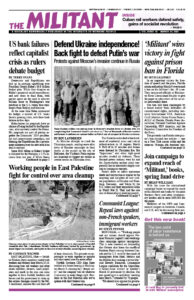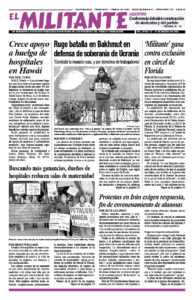The collapse of three regional banks and the underlying fall in the value of U.S. government bonds caused by rising interest rates is a symptom of the ongoing crisis of capitalist production and trade, and a harbinger of further crises to come.
So-called government bailouts — like President Joseph Biden handing out billions to protect wealthy capitalist depositors — are never aimed at protecting the checking accounts of workers or small-business owners. These decisions underscore the fact that the government serves the propertied ruling families.
For now, these steps have stemmed the plunge in the bond markets and averted further bank collapses. But some 2,315 U.S. banks with $11 trillion in assets still have fewer assets on their balance sheets than they would need to cover their liabilities.
Whatever the immediate future holds, capitalist competition will continue to sharpen and sooner or later new crises will break out. No new government regulation will alter the workings of dog-eat-dog capitalism. Rising trade in stocks and bonds and ever greater reliance on credit is an inevitable feature of our imperialist epoch. The bosses will be driven to deepen their attacks on workers and farmers.
And, as profits are threatened, the ruling rich will look for get-rich schemes and speculation.
Frederick Engels, a founder of the communist movement, explained all capitalist nations “are periodically seized by fits of giddiness in which they try to accomplish the money making without the mediation of the production process.”
The origins of today’s crisis are outlined in the 2002 article Capitalism’s Long Hot Winter Has Begun by Socialist Workers Party National Secretary Jack Barnes, available in New International no. 12. “It’s not the hi-tech mania, multiple bankruptcies or massive accounting frauds … that lie at the root of the current capitalist crisis,” he writes. “These are merely diversionary symptoms of the giant debt bubble built up by finance capital over nearly two decades to counteract growing global overproduction and downward pressure on profit rates.”
What these conditions will eventually lead to is not only more financial turmoil but increasing battles between the two main contending classes in modern society. The decadeslong retreat of the working class and our unions is behind us. The increasing confidence of workers to join together to fight for what we need can be seen in the strikes over the last couple of years by bakery workers, coal miners, truckers. And in the actions today of rail workers in Greece, trade unionists in France, fighters for rights in Iran and in the resistance of working people in Ukraine as they lead the battle against Moscow’s invasion. There are greater openings to act on the interests workers share in common worldwide and to build the nucleus of a class-struggle left-wing in the unions.
In the course of struggles that lie ahead class conscious workers will have the opportunity to act on the example set by workers and farmers in Cuba who uprooted capitalist rule and took political power into their own hands. Building proletarian parties here and worldwide is the road to leading millions to make a socialist revolution and open the door to a future free of the growing insecurity, crises and wars bred by capitalism — a future only the working class and its allies are capable of bringing into existence.
These questions and more will be taken up at the Socialist Workers Party-sponsored International Educational Conference in Oberlin June 8-11. For more information, contact the branch nearest you.

